全英文英语教案模板
英语教案设计万能模板全英文
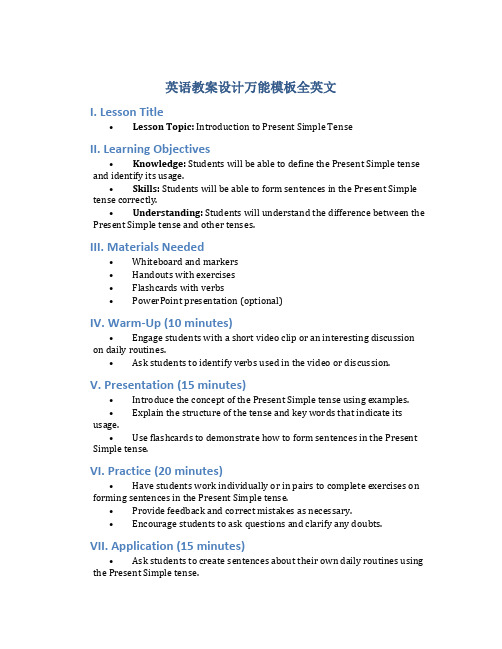
英语教案设计万能模板全英文I. Lesson Title•Lesson Topic: Introduction to Present Simple TenseII. Learning Objectives•Knowledge: Students will be able to define the Present Simple tense and identify its usage.•Skills: Students will be able to form sentences in the Present Simple tense correctly.•Understanding: Students will understand the difference between the Present Simple tense and other tenses.III. Materials Needed•Whiteboard and markers•Handouts with exercises•Flashcards with verbs•PowerPoint presentation (optional)IV. Warm-Up (10 minutes)•Engage students with a short video clip or an interesting discussion on daily routines.•Ask students to identify verbs used in the video or discussion.V. Presentation (15 minutes)•Introduce the concept of the Present Simple tense using examples.•Explain the structure of the tense and key words that indicate its usage.•Use flashcards to demonstrate how to form sentences in the Present Simple tense.VI. Practice (20 minutes)•Have students work individually or in pairs to complete exercises on forming sentences in the Present Simple tense.•Provide feedback and correct mistakes as necessary.•Encourage students to ask questions and clarify any doubts.VII. Application (15 minutes)•Ask students to create sentences about their own daily routines using the Present Simple tense.•Have students share their sentences with the class and provide peer feedback.VIII. Assessment (10 minutes)•Administer a short quiz to assess students’ understa nding of the Present Simple tense.•Review the quiz together as a class and address any common mistakes.IX. Closure (5 minutes)•Summarize the key points of the lesson on the Present Simple tense.•Encourage students to continue practicing the tense outside of class.X. Extension Activities (optional)•Assign homework exercises to reinforce the concept of the Present Simple tense.•Provide additional practice activities for students who want to further improve their skills in using the tense.This lesson plan template can be adapted and customized for teaching various topics in English. It provides a structured approach to designing effective English lessons that engage students and facilitate learning.。
英语教学教案模板英文版(10篇)

英语教学教案模板英文版(10篇)英语优秀教学设计篇一英语优秀教学设计篇二英语教案篇三标准英语教案篇十课前预备1、教学挂图。
2、教学投影片。
3、教学录音磁带。
4.6个地点场所的图片及单词卡片(师生各自预备)。
5、第25课交通工具及交通设施图片及单词卡片(师生各自预备)。
6、嬉戏用汽车站牌、交通工具头饰、售票员胸牌、乘车票等。
教学内容A Look, listen and talk.1、本局部利用图画引入单词。
2、学生通过看、听、说,学习5个地点场所的英文表达。
其中school 和zoo两个单词虽然在以前的学习中接触过,但是并未作为正式的单词消失过,此次正式列入生词表中,作为生词消失。
3、本局部单词的要求是:学生能将单词的音和相应的图形联系起来,并能看图用英文说出单词。
4、本局部学习内容的难点如下:(1)book store词组中失去爆破的读音;(2)地点及场所单词词义的识别。
5、初步练习用“Where are you going? Im going to.。
.。
”语句,询问某人要去哪儿和表达自己要去的地方。
6、初步练习询问某人乘坐什么交通工具并能答复。
7、本局部重点学习地点及场所单词的音、形、义/对语句的学习仅要求能初步感知,在B局部教学中应留意进展语句的稳固练习。
8、本局部能够涉及到的复习内容是:询问某物在哪儿的语句及表示方位的词。
此项复习内容为第27课学习指路和问路做了铺垫。
B Lets play and say.1、本局部的学习内容是学生通过嬉戏的方式进展模拟角色表演。
2、学生通过用语言做事情,娴熟把握所学地点场所的单词和询问某人要去哪儿的问答语。
3、本局部有一首关于开着车去某地方的。
歌曲,此歌曲协作学生模拟活动,不要求学生会唱,可以在今后的复习稳固中要求学生逐步学会此歌曲。
教学建议1、学生在学习新内容之前,教师应帮忙学生对第25课的学习内容进展复习。
2、教师出示教学挂图,请学生看图并听录音。
英语教案模板3篇
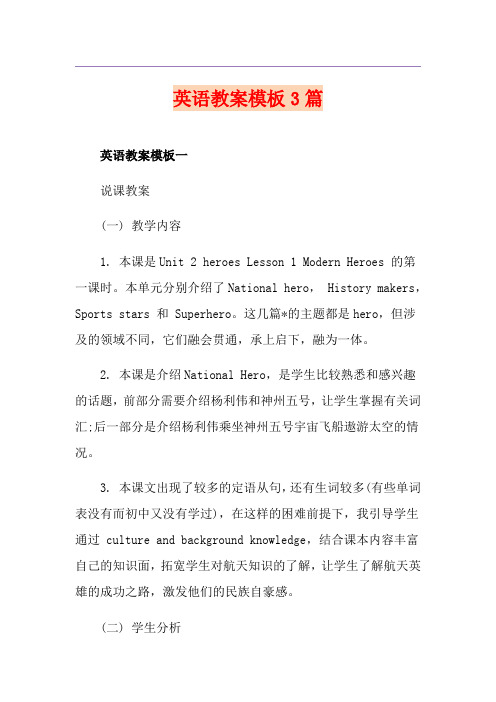
英语教案模板3篇英语教案模板一说课教案(一) 教学内容1. 本课是Unit 2 heroes Lesson 1 Modern Heroes 的第一课时。
本单元分别介绍了National hero, History makers,Sports stars 和 Superhero。
这几篇*的主题都是hero,但涉及的领域不同,它们融会贯通,承上启下,融为一体。
2. 本课是介绍National Hero,是学生比较熟悉和感兴趣的话题,前部分需要介绍杨利伟和神州五号,让学生掌握有关词汇;后一部分是介绍杨利伟乘坐神州五号宇宙飞船遨游太空的情况。
3. 本课文出现了较多的定语从句,还有生词较多(有些单词表没有而初中又没有学过),在这样的困难前提下,我引导学生通过 culture and background knowledge,结合课本内容丰富自己的知识面,拓宽学生对航天知识的了解,让学生了解航天英雄的成功之路,激发他们的民族自豪感。
(二) 学生分析1. 组成情况职业高中高一学生年龄都在14-16岁之间,大多数学生由于初中的知识基础打得不扎实,而且缺乏主动学习的能动性,自学能力差,对学习没有持有探究性和方向性,也没有养成良好英语学习习惯,所以学习成绩不太理想。
2. 学生的知识与技能水平职业高中招生的学生,基础知识比较薄弱,甚至连音标都不会读,词汇的掌握范围狭窄,影响了阅读,听力和作文。
学生的表达能力还是停留在比较低级的水平,面对每幅图片或某个主题只能说出一两句话,而且在阅读上,未能掌握泛读和精读的技巧和方法,课后的预习和复习能力较差,缺乏总结归纳的能力。
3. 学生已掌握的学习策略尽管学生的知识和技能水平一般,但经过了一定时间的训练后,他们还是掌握了pair work, group work, using the culture and background knowledge的阅读技巧。
(三) 教学目标1. 通过快速阅读*,学生能够对每段*进行归纳总结,准确地把段落主题与所给的headings联系起来。
英语教案模板范文5篇
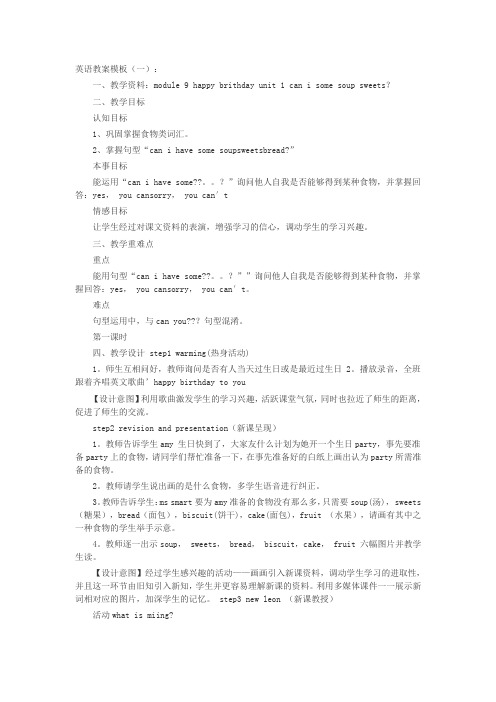
英语教案模板(一):一、教学资料:module 9 happy brithday unit 1 can i some soup sweets?二、教学目标认知目标1、巩固掌握食物类词汇。
2、掌握句型“can i have some soupsweetsbread?”本事目标能运用“can i have some??。
?”询问他人自我是否能够得到某种食物,并掌握回答:yes, you cansorry, you can′t情感目标让学生经过对课文资料的表演,增强学习的信心,调动学生的学习兴趣。
三、教学重难点重点能用句型“can i have some??。
?””询问他人自我是否能够得到某种食物,并掌握回答:yes, you cansorry, you can′t。
难点句型运用中,与can you???句型混淆。
第一课时四、教学设计 step1 warming(热身活动)1。
师生互相问好,教师询问是否有人当天过生日或是最近过生日 2。
播放录音,全班跟着齐唱英文歌曲’happy birthday to you【设计意图】利用歌曲激发学生的学习兴趣,活跃课堂气氛,同时也拉近了师生的距离,促进了师生的交流。
step2 revision and presentation(新课呈现)1。
教师告诉学生amy 生日快到了,大家友什么计划为她开一个生日party,事先要准备party上的食物,请同学们帮忙准备一下,在事先准备好的白纸上画出认为party所需准备的食物。
2。
教师请学生说出画的是什么食物,多学生语音进行纠正。
3。
教师告诉学生:ms smart要为amy准备的食物没有那么多,只需要soup(汤), sweets (糖果),bread(面包),biscuit(饼干),cake(面包),fruit (水果),请画有其中之一种食物的学生举手示意。
4。
教师逐一出示soup, sweets, bread, biscuit,cake, fruit 六幅图片并教学生读。
英语教案模板全英文版
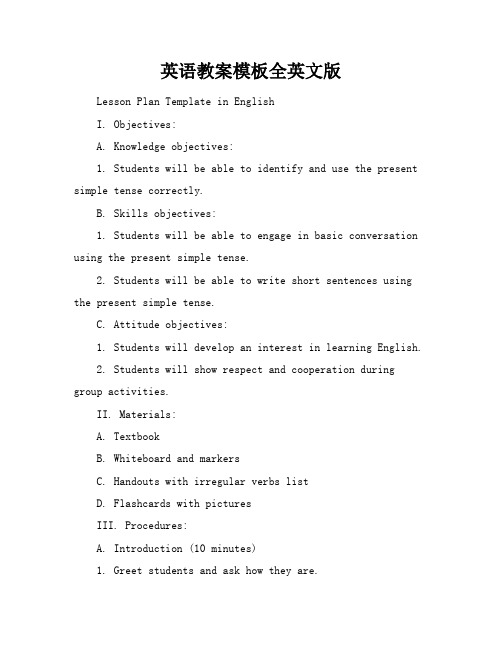
英语教案模板全英文版Lesson Plan Template in EnglishI. Objectives:A. Knowledge objectives:1. Students will be able to identify and use the present simple tense correctly.B. Skills objectives:1. Students will be able to engage in basic conversation using the present simple tense.2. Students will be able to write short sentences using the present simple tense.C. Attitude objectives:1. Students will develop an interest in learning English.2. Students will show respect and cooperation during group activities.II. Materials:A. TextbookB. Whiteboard and markersC. Handouts with irregular verbs listD. Flashcards with picturesIII. Procedures:A. Introduction (10 minutes)1. Greet students and ask how they are.2. Review the previous lesson and introduce the new topic: present simple tense.3. Explain the importance of using the present simpletense in everyday conversations.B. Presentation (15 minutes)1. Write the present simple tense form on the board (e.g., "I go to school every day").2. Explain the structure of the present simple tense (subject + verb in base form).4. Provide examples and nonexamples to clarify the concept.C. Practice (20 minutes)1. Divide students into pairs and give them flashcardswith pictures.2. Students ask and answer questions using the present simple tense (e.g., "What do you do every day?" "I go toschool every day.").3. Monitor students' progress and provide feedback.D. Production (15 minutes)1. Hand out a worksheet with short sentences using the present simple tense.3. Review answers together as a class.E. Group Activity (10 minutes)1. Divide students into groups of four.2. Each group writes a short dialogue using the present simple tense.3. Groups share their dialogues with the class.IV. Assessment:A. Observe students' participation and engagement during the lesson.B. Assess students' understanding of the present simple tense through their answers and participation in the group activity.V. Closure:A. Summarize the main points of the lesson.B. Encourage students to practice using the present simple tense outside of class.C. Assign homework: Write a short paragraph using the present simple tense about their daily routines.VI. Reflection:A. Reflect on the effectiveness of the lesson.B. Identify areas for improvement and make necessary adjustments for future lessons.。
关于英语教案模板范文8篇
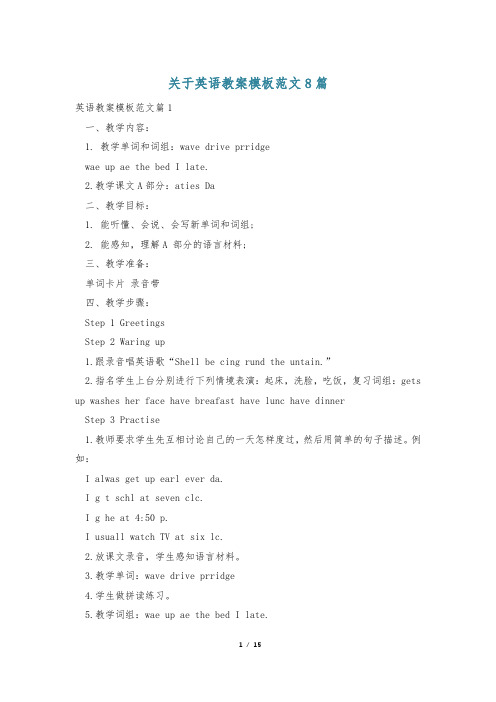
关于英语教案模板范文8篇英语教案模板范文篇1一、教学内容:1. 教学单词和词组:wave drive prridgewae up ae the bed I late.2.教学课文A部分:aties Da二、教学目标:1. 能听懂、会说、会写新单词和词组;2. 能感知,理解A 部分的语言材料;三、教学准备:单词卡片录音带四、教学步骤:Step 1 GreetingsStep 2 Waring up1.跟录音唱英语歌“Shell be cing rund the untain.”2.指名学生上台分别进行下列情境表演:起床,洗脸,吃饭,复习词组:gets up washes her face have breafast have lunc have dinnerStep 3 Practise1.教师要求学生先互相讨论自己的一天怎样度过,然后用简单的句子描述。
例如:I alwas get up earl ever da.I g t schl at seven clc.I g he at 4:50 p.I usuall watch TV at six lc.2.放课文录音,学生感知语言材料。
3.教学单词:wave drive prridge4.学生做拼读练习。
5.教学词组:wae up ae the bed I late.6.放课文录音,学生跟读课文。
Step 4 Cnslidatin学生自由读句子,熟悉课文。
Step 5 Hewr1.熟记本课单词和词组。
2.读熟课文。
英语教案模板范文篇2活动目标:学习单词bear(小熊) mountain(山) river(河流) 学唱儿歌The bear want over the mountain活动准备:单词卡片一个玩偶小熊活动过程:一、热身活动T: One, two, three.S: Be quite.T: Hello.S: Hello.T: Good morning, boys and girls.S: good morning, teacher.T: How are you?S: I’m fine. Thank you!T: Let’s sing, OK? the sing is“pussycat”二、学习新的儿歌1、出示小熊,并和孩子打招呼T: Hello, I’m bear.S: Hello, bear2、学习单词和儿歌,出示单词T: mountain, read after meS: mountainGame1把单词并排平铺在地上,边放边让幼儿读,请1个幼儿,人多了可以让幼儿分别站在单词两边,单词前放一组圈, 老师说:“Jump to …”(某个单词),幼儿可以“Jump to …”幼儿跳到单词后,可以问幼儿“What’s this?”。
(完整版)全英文英语教案模板
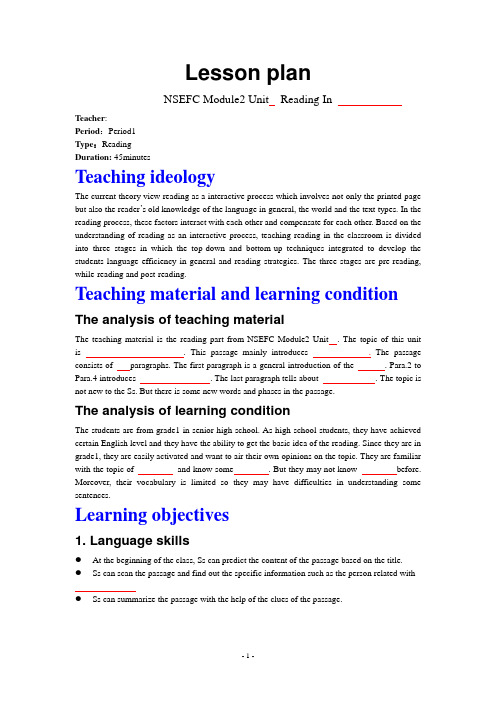
Lesson planNSEFC Module2 Unit Reading InTeacher:Period:Period1Type:ReadingDuration: 45minutesTeaching ideologyThe current theory view reading as a interactive process which involves not only the printed page but also the reader’s old knowledge of the language in general, the world and the text types. In the reading process, these factors interact with each other and compensate for each other. Based on the understanding of reading as an interactive process, teaching reading in the classroom is divided into three stages in which the top-down and bottom-up techniques integrated to develop the students language efficiency in general and reading strategies. The three stages are pre-reading, while-reading and post-reading.Teaching material and learning condition The analysis of teaching materialThe teaching material is the reading part from NSEFC Module2 Unit. The topic of this unit is . This passage mainly introduces .The passage consists of paragraphs. The first paragraph is a general introduction of the . Para.2 to Para.4 introduces . The last paragraph tells about . The topic is not new to the Ss. But there is some new words and phases in the passage.The analysis of learning conditionThe students are from grade1 in senior high school. As high school students, they have achieved certain English level and they have the ability to get the basic idea of the reading. Since they are in grade1, they are easily activated and want to air their own opinions on the topic. They are familiar with the topic of and know some. But they may not know before. Moreover, their vocabulary is limited so they may have difficulties in understanding some sentences.Learning objectives1. Language skills●At the beginning of the class, Ss can predict the content of the passage based on the title.●Ss can scan the passage and find out the specific information such as the person related with ●Ss can summarize the passage with the help of the clues of the passage.2. Language knowledge●Ss can master the key words and phrases of the passage as follows, .●Ss can learn , especially3. Affects●Ss will realize that and they will concern themselves with the issue of4. Cultural awareness●Ss will broaden their minds by knowing something about5. Learning strategies●Ss will cultivate their ability individual learning and cooperative learning by doing someactivities independently and some in groups.●Ss will communicate with each other in English while doing the group work. Language focuses and anticipated difficultiesLanguage focusesThis is a reading period so the focus is to cultivate the students’ reading skills. The many activities are designed to help Ss to train their reading skills, such as predicting, skimming, scanning and summarizing.It is also important for the Ss to master the new words and phrases.Anticipated difficultiesAs the Ss have a limited vocabulary, so they may have some difficulties in understanding the passage. So the teacher will help them learn the new words and phrases.Ss may did not heard before, so the teacher will tell them some background knowledge about it.Teaching methodThree-stage model: Based on the understanding of reading as an interactive process, teaching reading in the classroom is divided into three stages in which the top-down and bottom-up techniques integrated to develop the students language efficiency in general and reading strategies. The three stages are pre-reading, while-reading and post-reading.Teaching aidsMultimedia devices and PPT documents: In order to help Ss to fully understand the whole passage, I adopt Multimedia devices and PPT documents to bring the real-life situation into the classroom.Teaching proceduresStep1. Lead-in (6min)Activity1. Greetings and Free-talking (2min)T Leads into the topic by asking Ss some they know. Ss tell the name of the they know freely.T: Hello boys and girls.(Ss say hello to the teacher.)T: When we say , what appears in your minds?(Ss tell the things appear in their minds freely.)T: What are the ?(Ss tell some names of .)Activity2. Picture-talking (4min)T shows some pictures about the in China and abroad. After seeing the pictures, Ss are expected to tell the similarities of them.T: Just now, you talk about some in China. Now, let’s see some pictures of some . (T shows the pictures and Ss see them carefully.)T: What do the have in common?For example, they are very precious. What are your opinions?(T gives them some hints and Ss tell the characteristics of )[Aims]In this step, T first leads in the topic by talking with the Ss freely about the which is familiar to them and then Ss see some pictures and tell the characteristics. These two activities aim to arouse the Ss’interests in the topic and activate their old knowledge of . Then Ss will be mentally prepared for the reading comprehension. What’s more, when they are talking about the charateristics of, they will realize that the are rare and precious and they will concern themselves with the issue of .Step2. Pre-reading (3min)Activity1. Knowing something about (1min)T gives a brief introduction of the. Ss will know the.T: Today, we are going to learn . It is . Do you know what is? (T shows some pictures of and Ss get to know the .)Activity2. Predicting (2min)T asks Ss to read the title of the passage and then ask them some questions. Ss will predict the content of the passage with the help of the title.T: please look at the title “”, what does “动词” mean?(If the Ss can not give the answer, then T explain it.)T: In search means that people are looking for it. Why are people looking for it? Can you guess? What will the passage talk about?(Ss predict the content, but T will not give the answer here.)[Aims]In this step, the Ss first know some information of the ; the background information will make it easier for the Ss to understand the passage. Then T asks Ss to make predictions about the passage. It aims to help Ss develop the reading skills of predicting.Step3. While-reading (22min)Activity1. Skimming (4min)Ss skim the whole passage and find out and check their predictions.T: Why are people still ? Here is a multiple choice for you.Activity2. Scanning (3min)T presents several true or false statements and asks the Ss to scan the passage and judge the right from the wrong.(Keys: F,F,T,T,F)Activity3 Close-reading (15min)T designs various kinds of activities and Ss do the activities to fully understand the passage. Para.1T: Please read Para.1 carefully and then take some note about the .Para.2-4Please read Para.2-4 carefully and then find out the removal of the room.Please read Para.2-4 carefully and then find out the person related with the Amber Room and the things them down with it.Para.5Please read Para.5 carefully and then find out the the rebuilding of the amber room.[Aims]By doing some many activities, the Ss will develop their reading strategies and language efficiency. T help the Ss study the passage paragraph by paragraph.. Ss will learn some key words and phrases in the passage.Step4. Post-reading (12min)Activity1. Dissuasion (6min)Ss have learned the rebuilding of the passage and T asks the Ss to discuss whether people . T give the example of “” which is . Ss share their opinion on the issue and the reasons.Activity2. Role-play (6 min)T creates a situation in which a student of the class has visited the Amber Room, so he/she come back to introduce the amber room.Ss work in pairs, one act as the one who has visited the palace. The other acts as one who is curious about the Amber Room, they should make a dialogue.The beginning of the conversation is given.A: the one who has visited the palaceB: the one who is curious about the Amber Room[Aims]These two activities are to develop the Ss’comprehensive language competence. The role play serves to be an output of the reading and an evaluation of their learning.Homework (1min)Ss write a summery ofSs review the words and phrase of the passage and make sentence with each. Blackboard designInterpretationGood morning, ladies and gentlemen. It’s my great honor and pleasure to be here sharing my lesson with you.I have been ready to begin this representation with five parts. Analysis of the teaching material, the teaching aims, the important and difficult points, the studying methods, and the teaching procedure.Part 1 Teaching MaterialThe content of my lesson is New Senior English for China Book___ Unit____________________. This unit is about____________________ (topics). By studying of this unit, we’ll enable students to know_________________________ and develop the interest in___________________. At the same time, let the students learn how to____________________ (functional items). From this lesson, it starts___________________________(structures). (As we all know, reading belongs to the input during the process of the language learning. The input has great effect on output, such as speaking and writing.) Therefore, this lesson is in the important position of this unit. If the Ss can master it well, it will be helpful for them to learn the rest of this unit.Part 2 Teaching AimsAccording to the new standard curriculum and the syllabus (新课程标准和教学大纲), and after studying the teaching material, the teaching aims are the followings:1.Knowledge objects (语言目标:语音,词汇,语法,功能,话题)(1)The Ss can master the usage of the important words and expressions.(2)The Ss can use the __________________ (grammar) in the proper situation.(3)The Ss can understand the content of the lesson, talk about _______________________ (information) and get their own idea about_______________________________.2.Ability objects (技能目标:听,说,读,写)(1) To develop the Ss’abilities of listening, speaking, reading and writing(2) To guide Ss to set up effective studying strategies.(3) To improve the student’s reading ability, especially their skimming and scanningability.(4) To train the Ss’abilities of studying by themselves and cooperating .3.Emotion or moral objects (情感目标:兴趣,自信,合作,爱国,国际视野)(1)By completing the task, the Ss increase their interest in ____________________and set up self-confidence in _____________________.(2)Teach the Ss_________________________, put the moral education in the language study. Part 3 the Important and Difficult PointsBased on the requirement of the syllabus.The important points are__________________________ such as ______________. The difficult points are_________________________ for example_____________. Part 4 Teaching Methods As is known to us all, a good teaching method requires that the teacher should help Ss develop good sense of the English language. For achieving these teaching aims,1(after the analysis of the teaching material and teaching aims,) I will use the following methods according to the modern social communication teaching theories(现代社会交际教学理论) .1. Communicative Approach(交际教学法)2. Whole Language Teaching(整体语言教学法)3. Task-based Language Teaching (任务教学法)4. Total Situational Action (情景教学) a “scene —activity”teaching method , it establishes a real scene and the interaction between the teacher and the Ss. At the same time, CAI (电脑辅助教学) can provide a real situation with its sound and picture, it can develop the Ss creativity in learning English.Part 5 Teaching ProcedureStep 1. Lead-in. (_____min)___________________________________________________________________ Purpose of my design: (1) to catch Ss’attention about the class/topic/passage.(2) To set up suspense/develop interest in _______________.Step 2. Pre-readingTask 1. (Individual work, pair work, group work, class work; _____min)Let Ss _____________________________________________________________ Task 2. (Individual work, pair work, group work, class work; _____min)___________________________________________________________________ Now, let’s see what happened to the_______________/ let’s check whether it is right or not.Purpose of my design: (1) to get to know something about the _________________.(2) To have a better understanding about the importance of ___________________. Step 3. While-readingTask 1. (Individual work, pair work, group work, class work; _____min)Skimming: Ss should read the material fast to find out the main idea/topic sentence for each paragraph.Para 1 ___________________Para 2 ___________________Para 3 ___________________…Task 2. (Individual work, pair work, group work, class work; _____min)Scanning: Listen to the tape part by part to finish ___________________________.Task 3. (Individual work, pair work, group work, class work; _____min)Scanning: Guide Ss to read the material carefully and take some important notes, then answer the following questions.Task 4. (Individual work, pair work, group work, class work; _____min)Scanning: Ask Ss to read the material carefully and find out the correct answers to finish the following chart.第2/3页Purpose of my design: Enable students to understand the given material better by using different reading skills. And proper competition can arouse the Ss’interest in English learning. “Task-based”teaching method is used here to develop the Ss’ability of communication and also their ability of co-operation will be well trained. Step 4. Post-readingTask 1. (Individual work, pair work, group work, class work; _____min)(接task3)Ask Ss to close books and finish the summary according their notes. (接task4)Retell the story /Sum up the passage in Ss’own words according to the chart.Task 2. (Individual work, pair work, group work, class work; _____min)Discuss _______________________________________________with other group members and then choose a reporter to share their opinions about ____________________________________ with the whole class.Purpose of my design: I think If the Ss can finish this task well, they will benefit a lot in their spoken English. Most Ss can take their parts in the activities, especially for the Ss who have trouble in English study.Step 5. Homework1. __________________________________________________2. __________________________________________________Purpose of my design: Homework is so important and necessary for to master the knowledge they learned after class. It will check whether the Ss achieve the teaching aims.。
英语课教案万能模板(共6篇)

英语课教案万能模板〔共6篇〕第1篇:少儿英语教案模板少儿英语教案模板一、Teaching Demands and Aims(教学目的〕二、Teaching important and difficult point (教学重点〕1、words2、sentences3、grammars三、Teaching Aids (教具)四、Teaching procedures(教学过程〕 Greeting(问候〕warm up(热身〕 Review(复习〕 New Leon(新课〕 Step One: Step Two: Step Three: Follow up(叮咛〕五、Homework(作业布置〕作业的布置一、书面作业1、每节课后老师可适中选择课后习题(书本或课外参考书〕及字母作业。
2、低年纪的孩子合适听磁带读课文、画图、连线、写字母等简单作业;每学期两次测试:半期考和期末考试。
3、高年纪的孩子要求抄单词、背单词、背课文等书面作业;每节课前可做适当的听写练习;每个月可做适当的单元测试;期间两次大考:半期考和期末考。
二、磁带作业1、适时布置(条件允答应每周一次〕:将本周学习的内容录进磁带,下周上交。
2、录制要求:首先让学生和老师打招呼,接着报朗读单元,然后录作业内容,最后与老师说再见。
(如:Hello! Amanda.I am Go go.This is Unit 11……… Goodbye! Amanda!)3、听音修正:(1)书面记录:边听边把学生的错音登记在学生手册上。
(2)修正过程:A:打招呼,先表扬肯定,后提出错误,注意错音的跟读B:说悄悄话,增进师生感情交流 C:提出问题。
D:完毕Say:“ Good bye! ”三、教学1、时间安排:每月两次的教学,每生教学时间不超过8分钟。
2、教学内容:(1)本周学习单词及课文的朗读。
(2)词句的翻译。
(3)疑难解答。
(4)家长的经历交流。
第2篇:英语课教案英语课教案范文【篇1:高中英语教案范例】新年第一节英语课〔高一教案〕step i greetings and lead in〔问候以及导入〕1.happy new year!t: well, i am so happy to see you again after the long vacation.i wish everyone of you had a happy holiday.so how about your holiday? had you done some travel? 2.learn some expreions about “dragon”〔学习一些关于中国龙的习语、成语〕 t: this year is the year of dragon, so we will play a gueing game.i will show the english expreions and you try to gue the chinese expreions, long included. step ii revision〔复习〕1.dear, how many words can you still remember after a months winter holiday?2.2.how many phrases can you still remember?3.3.do you still remember the grammar very closely?there is no shortcut in the science road ,only be deligent.在科学上没有平坦的大道,只有不畏劳苦沿着陡峭山路攀登的人,才有希望到达光芒的顶点。
英语教案万能模板8篇

英语教案万能模板8篇优秀的教案是一定要明确好自己的教学目标写出的,为了活跃课堂,我们需要学会制定一份全面有效的教案,XX小编今天就为您带来了英语教案万能模板8篇,相信一定会对你有所帮助。
英语教案万能模板篇1一、教学内容今天我说课的内容是上海版牛津英语module 2 unit3 drinks i like的第一课时,通过信息技术的运用,学习单词thirsty, milk, juice和句型“what drink do you like i like …”本节课是在学生学习“i like …”之后进行教学的。
通过学习thirsty,感知句形“what drink do you like i like …”本课时的难度是句型的运用,以及对饮料的简单描述,但容量不是很大,并受到学生的喜爱。
二、教学目标英语课程标准》指出:激发和培养学生学习英语的兴趣,使学生树立自信心,养成良好的学习习惯和形成有效的学习策略,发展学生自主学习的能力和合作精神是小学英语教学的基本任务。
在认真分析教材的基础上,我针对学生实际,结合信息技术,将本课时的教学目标及重,难点确定如下:1、知识目标( 1 )学会用thirsty, milk, juice等表述单词。
( 2 )理解和初步运用“what drink do you like i like …”2、能力目标( 1 )能用“what drink do you like”来询问他人所喜爱的饮料。
( 2 )会用“i like ….”句型回答他人的询问。
( 3 )能简单描述自己所喜欢的饮料。
3、情感目标( 1 )懂得健康饮食,均衡饮食。
( 2 )学会感恩,学会感谢帮助自己的人。
三、教学重难点1、教学重点:理解和运用新授单词,理解和初步运用新授句型。
2、教学难点:能正确表达自己喜欢的饮料,并且进行描述。
四、教学准备教师准备单词卡片、图片、实物、媒体。
五、教学过程整堂课我利用现代教学媒体,充分向学生展示适当的语境,准确呈现语言信息,并且利用多媒体创设的情境进行合作互助学习,学习自由发挥运用英语的能力。
英语教学教案模板英文版优秀5篇
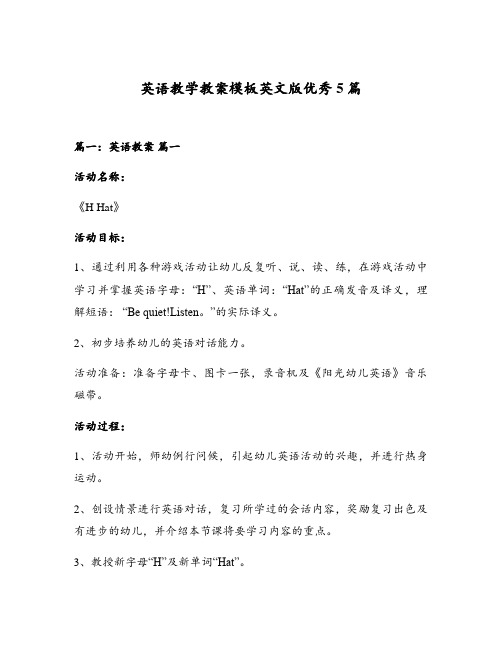
英语教学教案模板英文版优秀5篇篇一:英语教案篇一活动名称:《H Hat》活动目标:1、通过利用各种游戏活动让幼儿反复听、说、读、练,在游戏活动中学习并掌握英语字母:“H”、英语单词:“Hat”的正确发音及译义,理解短语:“Be quiet!Listen。
”的实际译义。
2、初步培养幼儿的英语对话能力。
活动准备:准备字母卡、图卡一张,录音机及《阳光幼儿英语》音乐磁带。
活动过程:1、活动开始,师幼例行问候,引起幼儿英语活动的兴趣,并进行热身运动。
2、创设情景进行英语对话,复习所学过的会话内容,奖励复习出色及有进步的幼儿,并介绍本节课将要学习内容的重点。
3、教授新字母“H”及新单词“Hat”。
(1)教师出示字母娃娃H,让幼儿说出像什么,在拼贴字母的过程中学会字母“H”的正确发音。
(2)教师利用图卡引出“帽子”的英语单词,通过游戏“贴帽子”让幼儿反复练习强化,逐渐掌握单词“Hat”的正确发音及译义。
4、律动教学。
教授幼儿短语“Be quiet!Listen。
”的实际译义及相应的动作。
5、教师小结,叮嘱幼儿:“回家要看VCD,回家要听录音机,回家要当Melody!”篇二:高中英语教学设计篇二一、课程类型:高三复习课二、教学目标:一) 认知目标1、句型和语言点(见教学重点)。
2、用所学的知识与伙伴进行交流、沟通,学会改错、写作。
二)情感目标利用多媒体手段营造积极和谐教学氛围,使学生不自觉地进入情景之中,充分调动学生的思维活动和情感体验,引起学生的共鸣。
三)智力目标在运用语言的过程中培养学生的观察力、分析力、想象力和自学能力,帮助学生加强记忆力,提高思维能力和运用英语的综合能力,激发创造能力。
三、教材分析:这是高三复习阶段的一节写作课。
这节书面表达课就从审题谋篇等方面入手来完成教学目的,侧重于引导学生在把握书面表达的写作前准备即谋篇审题能力,使学生在动手写作前迅速构思按照规范的模式来完成谋篇审题:在教学中不仅仅强调写,对于与写作紧密联系的听、说、读、改错都有兼顾。
英语教案模板全英文
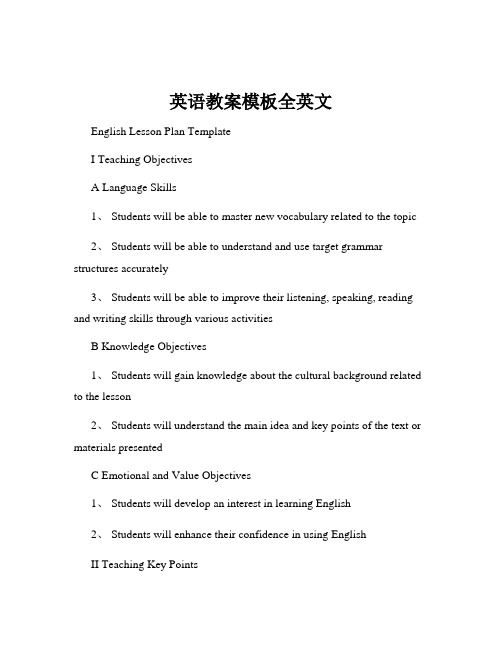
英语教案模板全英文English Lesson Plan TemplateI Teaching ObjectivesA Language Skills1、 Students will be able to master new vocabulary related to the topic2、 Students will be able to understand and use target grammar structures accurately3、 Students will be able to improve their listening, speaking, reading and writing skills through various activitiesB Knowledge Objectives1、 Students will gain knowledge about the cultural background related to the lesson2、 Students will understand the main idea and key points of the text or materials presentedC Emotional and Value Objectives1、 Students will develop an interest in learning English2、 Students will enhance their confidence in using EnglishII Teaching Key PointsA VocabularyIntroduce and explain new words and phrases that are essential for understanding the lessonB GrammarHighlight and explain the target grammar structure, and provide sufficient practiceC Text ComprehensionHelp students understand the main idea, details and logical structure of the textIII Teaching Difficult PointsA Complicated Grammar StructuresSolve students' confusion and difficulties in understanding and applying complex grammar rulesB Abstract ConceptsMake abstract or difficult concepts easier to understand through vivid examples and explanationsC Cultural DifferencesHelp students bridge the gap in understanding cultural differences to better comprehend the languageIV Teaching MethodsA Communicative ApproachEncourage students to communicate and interact in English to improve their language proficiencyB TaskBased LearningAssign various tasks to students to enhance their problemsolving skills and language application abilityC Multimedia TeachingUse pictures, videos, and audio materials to make the lesson more vivid and interestingV Teaching AidsA Textbooks and WorkbooksUse the prescribed textbooks and supplementary workbooks for systematic teaching and practiceB Multimedia ResourcesPrepare PPTs, videos, audio clips, and online materials to support teachingC Realia and ModelsUse real objects or models to help students understand and remember the knowledge betterVI Teaching ProcedureA Leadin1、 Start the class with a warmup activity such as a short video, a song, or a simple question to arouse students' interest and attention2、 Relate the warmup to the topic of the lesson and introduce the main learning objectivesB Presentation1、 Present new vocabulary and grammar through examples, pictures, or context2、 Explain the meaning and usage of the new language items clearly and simplyC Practice1、 Provide various exercises for students to practice the new vocabulary and grammar, such as fillintheblanks, sentencemaking, and translation2、 Organize pair or group work to allow students to practice communicating with each other using the new languageD Reading/Listening Comprehension1、 Present a reading or listening text related to the topic2、 Set comprehension questions to guide students to understand the main idea, details and key information of the textE Production1、 Ask students to apply the language they have learned to reallife situations, such as roleplay, debate, or composition writing2、 Provide feedback and correction to students' performanceF SummarySummarize the key points and language points learned in the lesson to reinforce students' memoryG HomeworkAssign appropriate homework to consolidate what has been learned in class, such as exercises, reading or writing tasksVII Blackboard DesignWrite the key vocabulary, grammar rules and important points on the blackboard during the lesson for students to refer toVIII Teaching ReflectionAfter the lesson, reflect on the teaching process and students' learning performance, summarize the strengths and weaknesses, and make improvements for future teachingThis is a basic template for an English lesson plan Depending on the specific content and teaching requirements, teachers can make appropriate adjustments and enrichments The key is to design a lesson that is interesting, effective and suitable for students' language level and learning needs。
英语教学设计模板优秀8篇
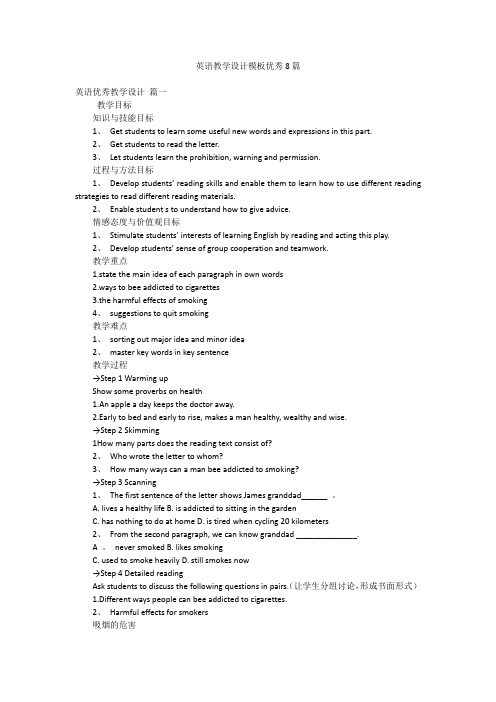
英语教学设计模板优秀8篇英语优秀教学设计篇一教学目标知识与技能目标1、Get students to learn some useful new words and expressions in this part.2、Get students to read the letter.3、Let students learn the prohibition, warning and permission.过程与方法目标1、Develop students’ reading skills and enable them to learn how to use different reading strategies to read different reading materials.2、Enable student s to understand how to give advice.情感态度与价值观目标1、Stimulate students’ interests of learning English by reading and acting this play.2、Develop students’ sense of group cooperation and teamwork.教学重点1.state the main idea of each paragraph in own words2.ways to bee addicted to cigarettes3.the harmful effects of smoking4、suggestions to quit smoking教学难点1、sorting out major idea and minor idea2、master key words in key sentence教学过程→Step 1 Warming upShow some proverbs on health1.An apple a day keeps the doctor away.2.Early to bed and early to rise, makes a man healthy, wealthy and wise.→Step 2 Skimming1How many parts does the reading text consist of?2、Who wrote the letter to whom?3、How many ways can a man bee addicted to smoking?→Step 3 Scanning1、The first sentence of the letter shows James granddad______ 。
英语教案万能模板全英

English Lesson Plan Universal TemplateI. IntroductionIn the English teaching field, a well-structured lesson plan is essential for effective teaching and learning. This universal template aims to provide a comprehensive guide for English educators in planning their lessons.II. Lesson Objectives1.To introduce new vocabulary related to a specific theme.2.To practice speaking and listening skills through interactive activities.3.To provide opportunities for students to improve reading and writingskills.III. Materials Needed•Whiteboard and markers•Handouts with exercises•Audio recordings for listening activities•Textbook or reading material related to the lesson theme IV. Warm-Up (10 minutes)•Engage students by asking open-ended questions related to the lesson topic.•Play a short video or audio clip to introduce the theme and generate interest.V. Presentation (15 minutes)•Introduce new vocabulary and language structures through visual aids.•Provide explanations and examples to ensure understanding.•Encourage student participation through interactive questioning.VI. Practice Activities (20 minutes)•Divide students into pairs or groups to practice the new language through role plays or discussions.•Conduct listening activities where students listen to recordings and answer comprehension questions.•Assign writing tasks to reinforce learning and language production.VII. Feedback and Correction (10 minutes)•Provide feedback on students’ performance during practice activities.•Correct errors and guide students on language use.•Encourage peer feedback and self-assessment.VIII. Wrap-Up (5 minutes)•Summarize key points covered in the lesson.•Give students an opportunity to ask questions or share their thoughts.•Assign homework or preview the next lesson topic.IX. Extension Activities (optional)•Provide additional practice exercises for students who finish early.•Use technology tools for further engagement, such as online quizzes or interactive learning platforms.X. ConclusionThis English lesson plan template offers a structured approach to designing engaging and effective lessons for students. By following this template, educators can create dynamic and interactive learning experiences that cater to diverse student needs and learning styles.Remember, adapt the template to suit the specific needs and proficiency levels of your students, and don’t be afraid to experiment with different activities and teaching methods to keep the lessons engaging and exciting.。
(完整版)全英文英语教案模板

Lesson planNSEFC Module2 Unit Reading InTeacher :Period : Period1Type : ReadingDuration:45minutesTeaching ideologyThe current theory view reading as a interactive process which involves not only the printed pagebut also the reader’s old knowledge of the language in general, the world and the text types. In the reading process, these factors interact with each other and compensate for each other. Based on the understanding of reading as an interactive process, teaching reading in the classroom is dividedinto three stages in which the top-down and bottom-up techniques integrated to develop the students language efficiency in general and reading strategies.The three stages are pre-reading, while-reading and post-reading.Teaching material and learning conditionThe analysis of teaching materialThe teaching material is the reading part from NSEFC Module2 Unit . The topic of this unit is. This passage mainly introduces. The passage consists of paragraphs. The first paragraph is a general introduction of the. Para.2 to Para.4 introduces. The last paragraph tells about. The topic is not new to the Ss. But there is some new words and phases in the passage.The analysis of learning conditionThe students are from grade1 in senior high school. As high school students, they have achieved certain English level and they have the ability to get the basic idea of the reading. Since they are in grade1, they are easily activated and want to air their own opinions on the topic. They are familiar with the topic of and know some . But they may not know before. Moreover, their vocabulary is limited so they may have difficulties in understanding some sentences.Learning objectives1. Language skillsAt the beginning of the class, Ss can predict the content of the passage based on the title. Ss can scan the passage and find out the specific information such as the person related withSs can summarize the passage with the help of the clues of the passage.nguage knowledgeSs can master the key words and phrases of the passage as follows,.Ss can learn, especially3.AffectsSs will realize that and they will concern themselves with the issue of4. Cultural awarenessSs will broaden their minds by knowing something about5. Learning strategiesSs will cultivate their ability individual learning and cooperative learning by doing some activities independently and some in groups.Ss will communicate with each other in English while doing the group work. Language focuses and anticipated difficultiesLanguage focusesThis is a reading period so the focus is to cultivate the students ’reading skills. The many activities are designed to help Ss to train their reading skills, such as predicting, skimming, scanning and summarizing.It is also important for the Ss to master the new words and phrases.Anticipated difficultiesAs the Ss have a limited vocabulary, so they may have some difficulties in understanding the passage. So the teacher will help them learn the new words and phrases.Ss may did not heard before, so the teacher will tell them some background knowledge about it.Teaching methodThree-stage model : Based on the understanding of reading as an interactive process, teaching reading in the classroom is divided into three stages in which the top-down and bottom-up techniques integrated to develop the students language efficiency in general and reading strategies. The three stages are pre-reading, while-reading and post-reading.Teaching aidsMultimedia devices and PPT documents: In order to help Ss to fully understand the whole passage, I adopt Multimedia devices and PPT documents to bring the real-life situation into the classroom.Teaching proceduresStep1. Lead-in (6min)Activity1. Greetings and Free-talking (2min)T Leads into the topic by asking Ss some they know. Ss tell the name of the they know freely.T: Hello boys and girls.(Ss say hello to the teacher.)T: When we say, what appears in your minds?(Ss tell the things appear in their minds freely.)T: What are the?(Ss tell some names of.)Activity2. Picture-talking (4min)T shows some pictures about the in China and abroad. After seeing the pictures, Ss are expected to tell the similarities of them.T: Just now, you talk about some in China. Now, let’s see some pictures of some. (T shows the pictures and Ss see them carefully.)T: What do the have in common ? For example, they are very precious. What are your opinions?(T gives them some hints and Ss tell the characteristics of)[Aims]In this step, T first leads in the topic by talking with the Ss freely about the which is familiar to them and then Ss see some pictures and tell the characteristics. These two activities aim to arouse the Ss’interests in the topic and activate their old knowledge of. Then Ss will be mentally prepared for the reading comprehension. What’s more, when they are talking about the charateristics of, they will realize that the are rare and precious and they will concern themselves with the issue of.Step2. Pre-reading (3min)Activity1. Knowing something about(1min)T gives a brief introduction of the. Ss will know the.T: Today, we are going to learn. It is. Do you know what is?(T shows some pictures of and Ss get to know the.)Activity2. Predicting (2min)T asks Ss to read the title of the passage and then ask them some questions. Ss will predict the content of the passage with the help of the title.T: please look at the title “”, what does“动词”mean?(If the Ss can not give the answer, then T explain it.)T:In search means that people are looking for it. Why are people looking for it? Can you guess? What will the passage talk about?(Ss predict the content, but T will not give the answer here.)[Aims]In this step, the Ss first know some information of the; the background information will make it easier for the Ss to understand the passage. Then T asks Ss to make predictions about the passage. It aims to help Ss develop the reading skills of predicting.Step3. While-reading (22min)Activity1. Skimming (4min)Ss skim the whole passage and find out and check their predictions.T: Why are people still? Here is a multiple choice for you.People are searching for the amber room, because________________.A.It is still in Russia.B.It is missing.(keys: B)Fill in the blank.The text is organized of in the order of ________________.(Keys: time)Activity2.Scanning (3min)T presents several true or false statements and asks the Ss to scan the passage and judge the right from the wrong.T: please Ss to scan the passage and judge the right from the wrong.statements T F 1The design of the room was in the style which is popular nowadays.2In fact, the room was made to be a gift.3Frederick William I decided not to keep it.4Russians removed some objects from the room before the Nazis arrived.5The Russians have built a new amber Room at the summer palace.(Keys: F,F,T,T,F )Activity3 Close-reading (15min)T designs various kinds of activities and Ss do the activities to fully understand the passage.T: Please read Para.1 carefully and then take some note about the.Materials: ____________________________________Design: ______________________________________Style: _______________________________________Decorations:__________________________________The length of time taken to complete:______________Please read Para.2-4 carefully and then find out the removal of the room.?KonigsbergThe summer palaceThe winter palacePrussiaPlease read Para.2-4 carefully and then find out the person related with the Amber Room and the things them down with it.people WhatFrederick William IPeter GreatCatherine IINazi AmyPlease read Para.5 carefully and then find out the the rebuilding of the amber room.WhoWhenWhatA new Amber RoomWhereWhy[Aims]By doing some many activities, the Ss will develop their reading strategies and language efficiency. T help the Ss study the passage paragraph by paragraph.. Ss will learn some key words and phrases in the passage.Step4. Post-reading (12min)Activity1. Dissuasion (6min)Ss have learned the rebuilding of the passage and T asks the Ss to discuss whether people . T give the example of “ ”which is . Ss share their opinion on the issue and the reasons.We should rebuild it.We should not rebuild it.____________________________________________________________________________________________________________________________________________________________________________________________________________________________Activity2. Role-play (6 min)T creates a situation in which a student of the class has visited the Amber Room, so he/she come back to introduce the amber room.Ss work in pairs, one act as the one who has visited the palace. The other acts as one who is curious about the Amber Room, they should make a dialogue.The beginning of the conversation is given.A:the one who has visited the palaceB:the one who is curious about the Amber RoomA:Last week, I visited the new Amber Room, the journey is so pleasant.B:could you please tell me something about the Amber Room?A:.[Aims]These two activities are to develop the Ss’comprehensive language competence. The role play serves to be an output of the reading and an evaluation of their learning.Homework (1min)Ss write a summery ofSs review the words and phrase of the passage and make sentence with each.Blackboard designUnit1 In Search of the Amber RoomValuableRareAt warIn returnCultural relics amazingfancystylePrecious receptionremoveInterpretationGood morning, ladies and gentlemen. It’ s my great honor and pleasure to be here sharing my lesson with you.I have been ready to begin this representation with five parts. Analysis of the teaching material,the teaching aims, the important and difficult points, the studying methods, and the teaching procedure.Part 1 Teaching MaterialThe content of my lesson is New Senior English for China Book___ Unit____________________. This unit is about____________________ (topics). By studying of this unit, we’ll enable students to know_________________________ and develop the interest in___________________. At the same time, let the students learn how to____________________ (functional items). From this lesson, it starts___________________________(structures). (As we all know, reading belongs to the input during the process of the language learning. The input has great effect on output, such as speaking and writing.) Therefore, this lesson is in the important position of this unit. If the Ss can master it well, it will be helpful for them to learn the rest of this unit.Part 2 Teaching AimsAccording to the new standard curriculum and the syllabus (新课程标准和教课纲领), and after studying the teaching material, the teaching aims are the followings:1.Knowledge objects ( 语言目标:语音,词汇,语法,功能,话题)(1)The Ss can master the usage of the important words and expressions.(2)The Ss can use the __________________ (grammar) in the proper situation.(3)The Ss can understand the content of the lesson, talk about _______________________ (information) and get their own idea about_______________________________.2.Ability objects ( 技术目标:听,说,读,写)(1)To develop the Ss’ abilities of listening, speaking, reading and writing(2)To guide Ss to set up effective studying strategies.(3)To improve the student ’ s reading ability, especially their skimming and scanningability.(4) To train the Ss ’ abilities of studying by themselves and cooperating .3.Emotion or moral objects ( 感情目标:兴趣,自信,合作,爱国,国际视线)(1)By completing the task, the Ss increase their interest in ____________________and set up self-confidence in _____________________.(2)Teach the Ss_________________________, put the moral education in the language study.Part 3 the Important and Difficult PointsBased on the requirement of the syllabus.The important points are__________________________ such as ______________. The difficult points are_________________________ for example_____________. Part 4 Teaching MethodsAs is known to us all, a good teaching method requires that the teacher should help Ssdevelop good sense of the English language. For achieving these teaching aims, 1(after the analysis of the teaching material and teaching aims,) I will use the following methods according to the modern social communication teaching theories( 现代社会社交教课理论 ) .municative Approach( 社交教课法 )2.Whole Language Teaching( 整体语言教课法 )3.Task-based Language Teaching (任务教课法 )4.Total Situational Action ( 情形教课 ) a “scene — activity ” teaching method , it establishes a real scene and the interaction between the teacher and the Ss. At the same time, CAI(电脑协助教课 ) can provide a real situation with its sound and picture, it can develop the Ss creativity in learning English.Part 5 Teaching ProcedureStep 1. Lead-in. (_____min)___________________________________________________________________Purpose of my design: (1) to catch Ss ’ attention about the class/topic/passage.(2)To set up suspense/develop interest in _______________.Step 2. Pre-readingTask 1. (Individual work, pair work, group work, class work; _____min)Let Ss _____________________________________________________________ Task 2. (Individual work, pair work, group work, class work; _____min)___________________________________________________________________ Now, let ’s see what happened to the_______________/ let ’ s check whether it is right or not.Purpose of my design: (1) to get to know something about the _________________.(2)To have a better understanding about the importance of ___________________. Step 3. While-readingTask 1. (Individual work, pair work, group work, class work; _____min)Skimming: Ss should read the material fast to find out the main idea/topic sentence for each paragraph.Para 1 ___________________Para 2 ___________________Para 3 ___________________Task 2. (Individual work, pair work, group work, class work; _____min)Scanning: Listen to the tape part by part to finish ___________________________.Task 3. (Individual work, pair work, group work, class work; _____min)Scanning: Guide Ss to read the material carefully and take some important notes, then answerthe following questions.Task 4. (Individual work, pair work, group work, class work; _____min)Scanning: Ask Ss to read the material carefully and find out the correct answers to finish the following chart.第 2/3页Purpose of my design: Enable students to understand the given material better by using different reading skills. And proper competition can arouse the Ss’ interest in English learning.“Task-based” teaching method is used here to develop the Ss ’ ability of communication and also their ability of co-operation will be well trained. Step 4. Post-readingTask 1. (Individual work, pair work, group work, class work; _____min)(接 task3)Ask Ss to close books and finish the summary according their notes. ( 接 task4)Retell the story /Sum up the passage in Ss’ own words according to the chart.Task 2. (Individual work, pair work, group work, class work; _____min)Discuss _______________________________________________with other group members and then choose a reporter to share their opinions about ____________________________________ with the whole class.Purpose of my design: I think If the Ss can finish this task well, they will benefit a lot in their spoken English. Most Ss can take their parts in the activities, especially for the Ss who have trouble in English study.Step 5. Homework1.__________________________________________________2.__________________________________________________Purpose of my design: Homework is so important and necessary for to master the knowledgethey learned after class. It will check whether the Ss achieve the teaching aims.。
2024年英语全英语教案模板8篇
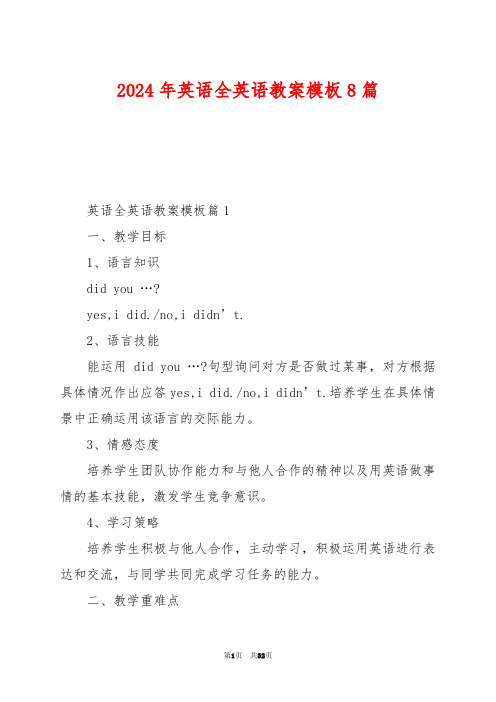
2024年英语全英语教案模板8篇英语全英语教案模板篇1一、教学目标1、语言知识did you …?yes,i did./no,i didn’t.2、语言技能能运用did you …?句型询问对方是否做过某事,对方根据具体情况作出应答yes,i did./no,i didn’t.培养学生在具体情景中正确运用该语言的交际能力。
3、情感态度培养学生团队协作能力和与他人合作的精神以及用英语做事情的基本技能,激发学生竞争意识。
4、学习策略培养学生积极与他人合作,主动学习,积极运用英语进行表达和交流,与同学共同完成学习任务的能力。
二、教学重难点能熟练运用did you …?句型对过去发生的事情进行推测。
Ⅰ.warm-up1.came: ①教师快速出示动词或动词词组,让学生快速做出该动作。
②让学生从另一组动词过去式中找出与图片配对的单词,学习和巩固不规则动词过去式。
如:go-went, meet-met, run-ran, buy-bought, eat-ate, see-saw.2.free talk用“旅游日记”或“假期影集”与组员谈论假日生活。
如:where did you go on vacation?what did you do?did you……?when did you come back?Ⅱ.pre-task1、教师出示提前收集的名胜风景区明信片,提问:“did you go to ……?” did you see……? did you buy……?2、教师出示英国伦敦的名胜风景区明信片,提问:“where did lingling go?”学生回答:“london”.教师问:“where did she go?what did she see/meet/buy?”学生回答后,教师引出课文活动5的歌曲:“listen to a song from amy”,学唱歌曲。
3、[任务呈现]——寄一张风景明信片给你的朋友教师展示伦敦明信片,并介绍:“this is from amy to daming.what did she say? let’s go and see.then please write about your yesterday to amy or your friends.”让我们一起瞧一瞧怎样写明信片呢?Ⅲ.while-task1、播放课文录音,并让学生回答课文活动的问题。
英语教案模板10篇
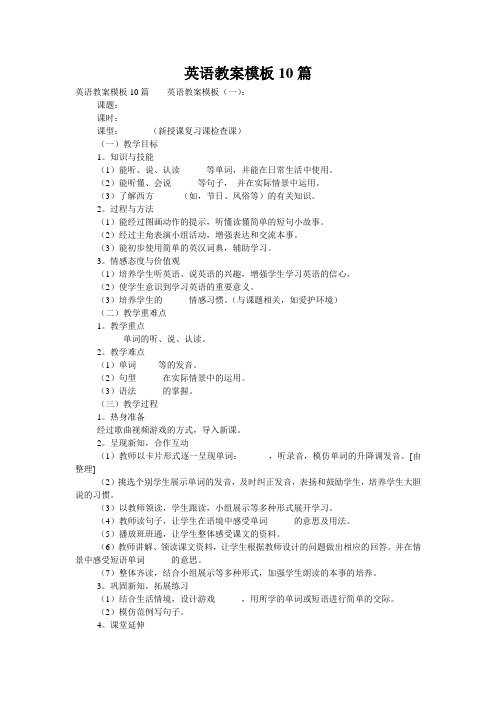
英语教案模板10篇英语教案模板10篇英语教案模板(一):课题:______课时:______课型:______(新授课复习课检查课)(一)教学目标1。
知识与技能(1)能听、说、认读______等单词,并能在日常生活中使用。
(2)能听懂、会说______等句子,并在实际情景中运用。
(3)了解西方______(如,节日、风俗等)的有关知识。
2。
过程与方法(1)能经过图画动作的提示,听懂读懂简单的短句小故事。
(2)经过主角表演小组活动,增强表达和交流本事。
(3)能初步使用简单的英汉词典,辅助学习。
3。
情感态度与价值观(1)培养学生听英语、说英语的兴趣,增强学生学习英语的信心。
(2)使学生意识到学习英语的重要意义。
(3)培养学生的______情感习惯。
(与课题相关,如爱护环境)(二)教学重难点1。
教学重点______单词的听、说、认读。
2。
教学难点(1)单词_____等的发音。
(2)句型______在实际情景中的运用。
(3)语法______的掌握。
(三)教学过程1。
热身准备经过歌曲视频游戏的方式,导入新课。
2。
呈现新知,合作互动(1)教师以卡片形式逐一呈现单词:______,听录音,模仿单词的升降调发音。
[由整理](2)挑选个别学生展示单词的发音,及时纠正发音,表扬和鼓励学生,培养学生大胆说的习惯。
(3)以教师领读,学生跟读,小组展示等多种形式展开学习。
(4)教师读句子,让学生在语境中感受单词______的意思及用法。
(5)播放班班通,让学生整体感受课文的资料。
(6)教师讲解、领读课文资料,让学生根据教师设计的问题做出相应的回答。
并在情景中感受短语单词______的意思。
(7)整体齐读,结合小组展示等多种形式,加强学生朗读的本事的培养。
3。
巩固新知,拓展练习(1)结合生活情境,设计游戏______,用所学的单词或短语进行简单的交际。
(2)模仿范例写句子。
4。
课堂延伸(1)听录音,读、背单词、句子。
(2)在生活中使用所学单词、句子。
小学英语教案全英文版范文
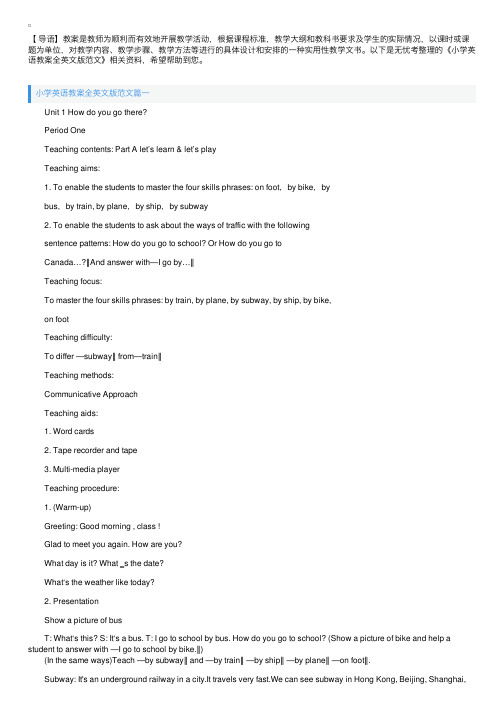
【导语】教案是教师为顺利⽽有效地开展教学活动,根据课程标准,教学⼤纲和教科书要求及学⽣的实际情况,以课时或课题为单位,对教学内容、教学步骤、教学⽅法等进⾏的具体设计和安排的⼀种实⽤性教学⽂书。
以下是⽆忧考整理的《⼩学英语教案全英⽂版范⽂》相关资料,希望帮助到您。
⼩学英语教案全英⽂版范⽂篇⼀ Unit 1 How do you go there? Period One Teaching contents: Part A let’s learn & let’s play Teaching aims: 1. To enable the students to master the four skills phrases: on foot,by bike,by bus,by train, by plane,by ship,by subway 2. To enable the students to ask about the ways of traffic with the following sentence patterns: How do you go to school? Or How do you go to Canada…?‖And answer with―I go by…‖ Teaching focus: To master the four skills phrases: by train, by plane, by subway, by ship, by bike, on foot Teaching difficulty: To differ ―subway‖ from―train‖ Teaching methods: Communicative Approach Teaching aids: 1. Word cards 2. Tape recorder and tape 3. Multi-media player Teaching procedure: 1. (Warm-up) Greeting: Good morning , class ! Glad to meet you again. How are you? What day is it? What ‗s the date? What‘s the weather like today? 2. Presentation Show a picture of bus T: What‘s this? S: It‘s a bus. T: I go to school by bus. How do you go to school? (Show a picture of bike and help a student to answer with ―I go to school by bike.‖) (In the same ways)Teach ―by subway‖ and ―by train‖―by ship‖―by plane‖―on foot‖. Subway: It's an underground railway in a city.It travels very fast.We can see subway in Hong Kong, Beijing, Shanghai,Gongzhou… Explain the differences between subway and train Pay attention to the pre. ― by‖& ―on‖ 3. Play games Ask one S to the front and stick the word cards next to the phrases written on the Bb when T read the new phrases quickly and the other Ss put up their cards. The one who reflect fastest and correctly is the winner. 4. Listen to the tape of Part A Let‘s learn and follow it. Pay attention to the tone and pronunciation 5. Practice: Let‘s play T Offer many places (the USA. England Australia Hong Kong Shanghai Guangzhou the moon…) and traffic ways (by car/ taxi/ bus… on foot) Ss practice with above places and ways in pairs: A: How do you go to school? B: I go to school on foot . Encourage the Ss to make up as many sentences as they can. 6. Spelling competition Divide the class into tow groups. Show the pictures of traffic tools and ask Ss to spell the phrases. The first one who puts up hand gets the chance to spell. The group spell out more phrases are the winners. Homework Copy the new words and phrases Finish Page1 of the AB⼩学英语教案全英⽂版范⽂篇⼆ Goood moring, I'm glad to interpret my lesson here . The lesson plan I am going to talk about is Part A let's learn of unit1 PEP Primary English book7. I will explain how to teach and the reason for doing this from following aspects. Ⅰ analysis of the teaching content. Ⅱ ways of teaching and learning . Ⅲ teaching procedures Ⅳ blackboard design V assessment Now Let’s focus on the analysis of teaching content. It can be divided into 3 parts as followed: the status and the function, the teaching objectives , the main points and difficult points, I’ll talk about it one by one. This lesson is the first lesson of unit 1, book7 . It includes two parts: Let’s learn and let’s play. In section 1, it mainly deals with these key phrases: on foot, by bike, by bus, by train, by subway. And in section 2, it provides a game for the Ss to prastise the patterns: How do you go to…? And the answer: I go… by../ on foot. Our students have already known some vehicles in the daily life. It’s not difficult for them to understand and use these words . If students can learn it well, it will help students to learn the rest of this unit. So, I set the following aims: The first is language objectives To make sure that students can read, recognize and use these key phrases :on foot ,by bike,by bus,by train skillfully. The next is ability objectives (1) To develop Ss’ abilities of listening and speaking. (2) To train the Ss’ ability of working in groups. moral objectives (1)to help students know some vehicles and comprehend the traffic rules (2) To foster Ss’ consciousness of good co-operation and proper competition. The main points and difficult points about this lesson is: (1) To make sure that Ss can use these key phrases correctly and skillfully. (2) To enable Ss to study in groups and co-operate skillfully. (3) To develop Ss’ interest in English. Difficult points To help the Ss ask and answer the question “How do you go to…? part Ⅱways of teaching and learning As we all know: the main instructional aims of learning English in primary school is to cultivate pupils’ basic abilities of listening and speaking and their good sense of the English language. So in this lesson I’ll mainly use “Task-based” teaching method. That is to say, I will let the Ss learn in real situations, finish a task by making a survey”How do you go to school?” to help Ss to get a better understanding of the key phrases. I will arrange these activities: guessing game, finishing a survey and having a competition. And in this lesson a recorder, CAI, will be needed. partⅢ teaching procedures I’ll finish this lesson in five steps. step1 lead--in activities I will begin my class with "drawing and guessing" game, just like this : I show students some vehicles such as bike ,bus ,jeep which they learned before by "Stick Figures" and ask them guess what’s it. Purpose: It is important to form a better English learning surrounding for the Ss by guessing game. and at the same time it provides situations to review learned knowledge for the next step. step2 prestentation Now I’ll mainly talk about this step. 1、first there is a Free talk between T and Ss. For example: I show many pictures of beautiful cities and ask students some questions, such as "do you like this city?where do you want to go ?"and help Ss to answer them with "by train ,by plane,by ship". By the way, I show the picture of a school, and say“ I go to schiool by bus” ,Ss read this sentence. do the actions and ask "how do you go to school?",show many pictures of tools such as ,on foot by bike ,by bus to help students answer my question one by one. To present the key structures one by one is much easier for the Ss to learn and grasp the meanings. 2 With the help of the CAI I set a situation to help Ss understand the way of using these key phrases: A boy is coming, who is going to school. He says: I go to school by.Then play the sounds of bus, bike ask students to listen carefully and tell “I go to school by." according to the different sounds, by the way , I present another new phrases:by subway Purpose:Make Ss use these new phrases with sentence structures, to help Ss use the language in a real situation.。
- 1、下载文档前请自行甄别文档内容的完整性,平台不提供额外的编辑、内容补充、找答案等附加服务。
- 2、"仅部分预览"的文档,不可在线预览部分如存在完整性等问题,可反馈申请退款(可完整预览的文档不适用该条件!)。
- 3、如文档侵犯您的权益,请联系客服反馈,我们会尽快为您处理(人工客服工作时间:9:00-18:30)。
Lesson planNSEFC Module2 Unit Reading InTeacher:Period:Period1Type:ReadingDuration: 45minutesTeaching ideologyThe current theory view reading as a interactive process which involves not only the printed page but also the reader’s old knowledge of the language in general, the world and the text types. In the reading process, these factors interact with each other and compensate for each other. Based on the understanding of reading as an interactive process, teaching reading in the classroom is divided into three stages in which the top-down and bottom-up techniques integrated to develop the students language efficiency in general and reading strategies. The three stages are pre-reading, while-reading and post-reading.Teaching material and learning conditionThe analysis of teaching materialThe teaching material is the reading part from NSEFC Module2 Unit. The topic of this unit is . This passage mainly introduces . The passage consists of paragraphs. The first paragraph is a general introduction of the . Para.2 to Para.4 introduces . The last paragraph tells about . The topic is not new to the Ss. But there is some new words and phases in the passage.The analysis of learning conditionThe students are from grade1 in senior high school. As high school students, they have achieved certain English level and they have the ability to get the basic idea of the reading. Since they are in grade1, they are easily activated and want to air their own opinions on the topic. They are familiar with the topic of and know some. But they may not know before. Moreover, their vocabulary is limited so they may have difficulties in understanding some sentences. Learning objectives1. Language skills●At the beginning of the class, Ss can predict the content of the passage based on the title.●Ss can scan the passage and find out the specific information such as the person related with●Ss can summarize the passage with the help of the clues of the passage.2. Language knowledge●Ss can master the key words and phrases of the passage as follows, .●Ss can learn , especially3. Affects●Ss will realize that and they will concern themselves with the issue of4. Cultural awareness●Ss will broaden their minds by knowing something about5. Learning strategies●Ss will cultivate their ability individual learning and cooperative learning by doing some activitiesindependently and some in groups.●Ss will communicate with each other in English while doing the group work. Language focuses and anticipated difficulties Language focusesThis is a reading period so the focus is to cultivate the students’ reading skills. The many activities are designed to help Ss to train their reading skills, such as predicting, skimming, scanning and summarizing.It is also important for the Ss to master the new words and phrases.Anticipated difficultiesAs the Ss have a limited vocabulary, so they may have some difficulties in understanding the passage. So the teacher will help them learn the new words and phrases.Ss may did not heard before, so the teacher will tell them some background knowledge about it.Teaching methodThree-stage model: Based on the understanding of reading as an interactive process, teaching reading in the classroom is divided into three stages in which the top-down and bottom-up techniques integrated to develop the students language efficiency in general and reading strategies. The three stages are pre-reading, while-reading and post-reading.Teaching aidsMultimedia devices and PPT documents: In order to help Ss to fully understand the whole passage, I adopt Multimedia devices and PPT documents to bring the real-life situation into the classroom.Teaching proceduresStep1. Lead-in (6min)Activity1. Greetings and Free-talking (2min)T Leads into the topic by asking Ss some they know. Ss tell the name of the they know freely.T: Hello boys and girls.(Ss say hello to the teacher.)T: When we say , what appears in your minds?(Ss tell the things appear in their minds freely.)T: What are the ?(Ss tell some names of .)Activity2. Picture-talking (4min)T shows some pictures about the in China and abroad. After seeing the pictures, Ss are expected to tell the similarities of them.T: Just now, you talk about some in China. Now, let’s see some pictures of some . (T shows the pictures and Ss see them carefully.)T: What do the have in common?For example, they are very precious. What are your opinions?(T gives them some hints and Ss tell the characteristics of )[Aims]In this step, T first leads in the topic by talking with the Ss freely about the which is familiar to them and then Ss see some pictures and tell the characteristics. These two activities aim to arouse the Ss’ interests in the topic and activate their old knowledge of . Then Ss will be mentally prepared for the reading comprehension. What’s more, when they are talking about the charateristics of, they will realize that the are rare and precious and they will concern themselves with the issue of .Step2. Pre-reading (3min)Activity1. Knowing something about (1min)T gives a brief introduction of the. Ss will know the.T: Today, we are going to learn . It is . Do you know what is?(T shows some pictures of and Ss get to know the .)Activity2. Predicting (2min)T asks Ss to read the title of the passage and then ask them some questions. Ss will predict the content of the passage with the help of the title.T: please look at the title “”, what does “动词” mean?(If the Ss can not give the answer, then T explain it.)T: In search means that people are looking for it. Why are people looking for it? Can you guess? What will the passage talk about?(Ss predict the content, but T will not give the answer here.)[Aims]In this step, the Ss first know some information of the ; the background information will make it easier for the Ss to understand the passage. Then T asks Ss to make predictions about the passage. It aims to help Ss develop the reading skills of predicting.Step3. While-reading (22min)Activity1. Skimming (4min)Ss skim the whole passage and find out and check their predictions.T: Why are people still ? Here is a multiple choice for you.Activity2. Scanning (3min)T presents several true or false statements and asks the Ss to scan the passage and judge the right from the wrong.T: please Ss to scan the passage and judge the right from the wrong.Activity3 Close-reading (15min)T designs various kinds of activities and Ss do the activities to fully understand the passage.Para.1T: Please read Para.1 carefully and then take some note about the .Para.2-4Please read Para.2-4 carefully and then find out the removal of the room.Please read Para.2-4 carefully and then find out the person related with the Amber Room and the things them down with it.Para.5Please read Para.5 carefully and then find out the the rebuilding of the amber room.[Aims]By doing some many activities, the Ss will develop their reading strategies and language efficiency. T help the Ss study the passage paragraph by paragraph.. Ss will learn some key words and phrases in the passage.Step4. Post-reading (12min)Activity1. Dissuasion (6min)Ss have learned the rebuilding of the passage and T asks the Ss to discuss whether people. T give the example of “” which is . Ss share their opinion on the issue and the reasons.Activity2. Role-play (6 min)T creates a situation in which a student of the class has visited the Amber Room, so he/she come back to introduce the amber room.Ss work in pairs, one act as the one who has visited the palace. The other acts as one who is curious about the Amber Room, they should make a dialogue.The beginning of the conversation is given.A: the one who has visited the palaceB: the one who is curious about the Amber Room[Aims]These two activities are to develop the Ss’comprehensive language competence. The role play serves to be an output of the reading and an evaluation of their learning.Homework (1min)Ss write a summery ofSs review the words and phrase of the passage and make sentence with each. Blackboard designGood morning, ladies and gentlemen. It’s my great honor and pleasure to be here sharing my lesson with you.I have been ready to begin this representation with five parts. Analysis of the teaching material, the teaching aims, the important and difficult points, the studying methods, and the teaching procedure. Part 1 Teaching MaterialThe content of my lesson is New Senior English for China Book___ Unit____________________. This unit is about____________________ (topics). By studying of this unit, we’ll enable students to know_________________________ and develop the interest in___________________. At the same time, let the students learn how to____________________ (functional items). From this lesson, it starts___________________________(structures). (As we all know, reading belongs to the input during the process of the language learning. The input has great effect on output, such as speaking and writing.) Therefore, this lesson is in the important position of this unit. If the Ss can master it well, it will be helpful for them to learn the rest of this unit.Part 2 Teaching AimsAccording to the new standard curriculum and the syllabus (新课程标准和教学大纲), and after studying the teaching material, the teaching aims are the followings:1.Knowledge objects (语言目标:语音,词汇,语法,功能,话题)(1)The Ss can master the usage of the important words and expressions.(2)The Ss can use the __________________ (grammar) in the proper situation.(3)The Ss can understand the content of the lesson, talk about _______________________ (information) and get their own idea about_______________________________.2.Ability objects (技能目标:听,说,读,写)(1) To develop the Ss’abilities of listening, speaking, reading and writing(2) To guide Ss to set up effective studying strategies.(3) To improve the student’s reading ability, especially their skimming and scanningability.(4) To train the Ss’abilities of studying by themselves and cooperating .3.Emotion or moral objects (情感目标:兴趣,自信,合作,爱国,国际视野)(1)By completing the task, the Ss increase their interest in ____________________and set up self-confidence in _____________________.(2)Teach the Ss_________________________, put the moral education in the language study.Part 3 the Important and Difficult PointsBased on the requirement of the syllabus.The important points are__________________________ such as ______________. The difficult points are_________________________ for example_____________. Part 4 Teaching MethodsAs is known to us all, a good teaching method requires that the teacher should help Ss develop good sense of the English language. For achieving these teaching aims,1(after the analysis of the teaching material and teaching aims,) I will use the following methods according to the modern social communication teaching theories(现代社会交际教学理论) .1. Communicative Approach(交际教学法)2. Whole Language Teaching(整体语言教学法)3. Task-based Language Teaching (任务教学法)4. Total Situational Action (情景教学) a “scene —activity”teaching method , it establishes a real scene and the interaction between the teacher and the Ss. At the same time, CAI (电脑辅助教学) can provide a real situation with its sound and picture, it can develop the Ss creativity in learning English.Part 5 Teaching ProcedureStep 1. Lead-in. (_____min)___________________________________________________________________ Purpose of my design: (1) to catch Ss’attention about the class/topic/passage.(2) To set up suspense/develop interest in _______________.Step 2. Pre-readingTask 1. (Individual work, pair work, group work, class work; _____min)Let Ss _____________________________________________________________ Task 2. (Individual work, pair work, group work, class work; _____min)___________________________________________________________________ Now, let’s see what happened to the_______________/ let’s check whether it is right or not.Purpose of my design: (1) to get to know something about the _________________.(2) To have a better understanding about the importance of ___________________. Step 3. While-readingTask 1. (Individual work, pair work, group work, class work; _____min)Skimming: Ss should read the material fast to find out the main idea/topic sentence for each paragraph.Para 1 ___________________Para 2 ___________________Para 3 ___________________…Task 2. (Individual work, pair work, group work, class work; _____min)Scanning: Listen to the tape part by part to finish ___________________________.Task 3. (Individual work, pair work, group work, class work; _____min)Scanning: Guide Ss to read the material carefully and take some important notes, then answer the following questions.Task 4. (Individual work, pair work, group work, class work; _____min)Scanning: Ask Ss to read the material carefully and find out the correct answers to finish the following chart.第2/3页Purpose of my design: Enable students to understand the given material better by using different reading skills. And proper competition can arouse the Ss’interest in English learning. “Task-based”teaching method is used here to develop the Ss’ability of communication and also their ability of co-operation will be well trained. Step 4. Post-readingTask 1. (Individual work, pair work, group work, class work; _____min)(接task3)Ask Ss to close books and finish the summary according their notes. (接task4)Retell the story /Sum up the passage in Ss’own words according to the chart.Task 2. (Individual work, pair work, group work, class work; _____min)Discuss _______________________________________________with other group members and then choose a reporter to share their opinions about ____________________________________ with the whole class.Purpose of my design: I think If the Ss can finish this task well, they will benefit a lot in their spoken English. Most Ss can take their parts in the activities, especially for the Ss who have trouble in English study.Step 5. Homework1. __________________________________________________2. __________________________________________________Purpose of my design: Homework is so important and necessary for to master the knowledge they learned after class. It will check whether the Ss achieve the teaching aims.。
